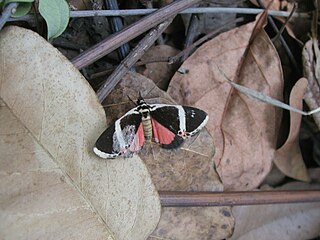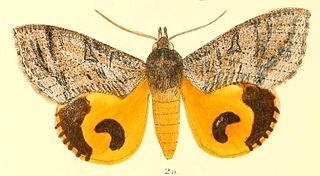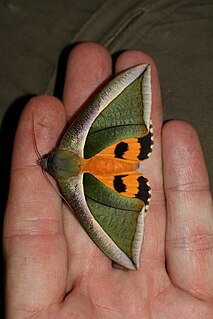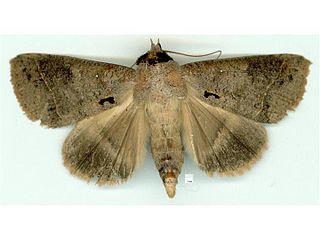
The Calpinae are a subfamily of moths in the family Erebidae described by Jean Baptiste Boisduval in 1840. This subfamily includes many species of moths that have a pointed and barbed proboscis adapted to piercing the skins of fruit to feed on juice, and in the case of the several Calyptra species of vampire moths, to piercing the skins of mammals to feed on blood. The subfamily contains some large moths with wingspans longer than 5 cm (2 in).
Termessa is a genus of moths in the subfamily Arctiinae The genus was described by Newman in 1856.

Artena is a genus of moths in the family Erebidae. The genus was erected by Francis Walker in 1858.

Colbusa is a genus of moths of the family Noctuidae erected by Francis Walker in 1865. There are three species:

Eudocima is a genus of moths of the family Erebidae first described by Gustaf Johan Billberg in 1820.

Mocis is a genus of moths in the family Erebidae. The genus was erected by Jacob Hübner in 1823.

Eudocima materna, the dot-underwing moth, is a moth of the family Erebidae found in widespread parts of the world, mainly in tropical Asia extending to New Guinea and Australia as well as in Africa. Reports from the United States, Canada and the French Antilles are now considered to be Eudocima apta. The species can be differentiated from other Eudocima moths by the presence of small central black dot in each hindwing. The species was first described by Carl Linnaeus in his 1767 12th edition of Systema Naturae.
Eudocima anguina is a moth of the family Erebidae first described by William Schaus in 1911. It is found in South America and in most of Costa Rica.
Eudocima apta is a moth of the family Erebidae. It is found in large parts of Brazil. At times it migrates north into the United States. The wingspan is about 45 mm.

Eudocima phalonia, the common fruit-piercing moth, is a fruit piercing moth of the family Erebidae. The species was first described by Carl Linnaeus in his 1763 Centuria Insectorum. It is found in large parts of the tropics, mainly in Asia, Africa and Australia but introduced into other areas such as Hawaii, New Zealand and the Society Islands. It is one of major fruit pests in the world.

Eudocima cajeta is a moth of the family Erebidae first described by Pieter Cramer in 1775. It is found in Sri Lanka, India and Indonesia.

Eudocima salaminia, the green fruit-piercing moth, is a moth of the family Erebidae. The species was first described by Pieter Cramer in 1777. It is found from India, and across south-east Asia to the Pacific Islands. In Australia it occurs in the Northern Territory, Queensland and New South Wales. The adult is a fruit piercer.

Eudocima tyrannus is a moth of the family Erebidae first described by Achille Guenée in 1852. It is found in south-eastern Siberia, India, eastern China, the Philippines and Japan.
Termessa discrepans is a moth in the subfamily Arctiinae. It was described by Francis Walker in 1865. It is found in Australia, where it has been recorded from the Australian Capital Territory, New South Wales, Queensland and Victoria.

Pantydia metaspila is a species of moth of the family Erebidae first described by Francis Walker in 1858. It is found in China, Japan (Ryukyus), India (Maharashtra), Thailand, Taiwan, the Maledives, Sri Lanka, the Philippines, Borneo, Sumatra, Sulawesi, the Tanimbar Islands, Seram, Papua New Guinea, the Caroline Islands, the Solomon Islands, Vanuatu, Fiji, as well as Australia, where it has been recorded from Queensland.

Eudocima serpentifera is a species of fruit-piercing moth in the family Erebidae first described by Francis Walker in 1858. It is found in North America.













